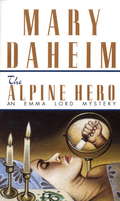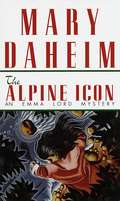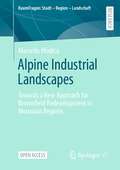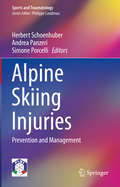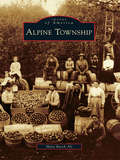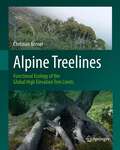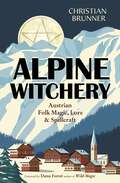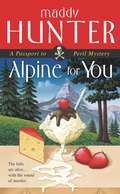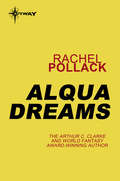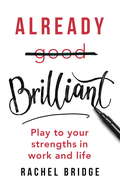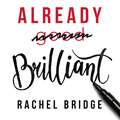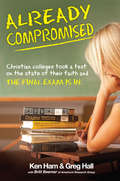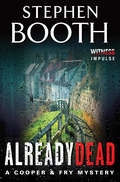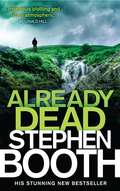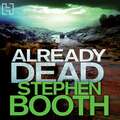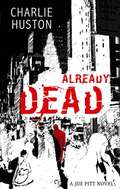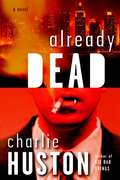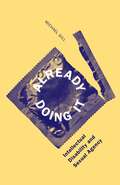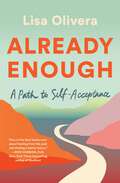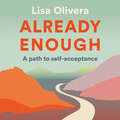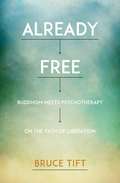- Table View
- List View
Alpine Hero: An Emma Lord Mystery (Emma Lord #8)
by Mary DaheimTHE ALPINE ADVOCATE SCOOPS A MURDEREmma Lord, the Advocate's editor, finds the body in the facial room of Stella's Styling Salon *anonymous under a mud pack, throat slashed.The victim turns out to be the sister-in-law of Sheriff Dodge's girlfriend, who had initially made the appointment for herself. Perhaps she was the killer's intended target. After all, no one in Alpine really knew the dead woman personally. Then rumors begin to fly, shady strangers turn up in town, and a young woman disappears into thin air. What looks like the story of the year is fast developing, and Emma means to have it *or die trying . . .From the Paperback edition.
Alpine Icon: An Emma Lord Mystery (Emma Lord #9)
by Mary DaheimALL THE MURDER FIT TO PRINT Editor-publisher Emma Lord and her Alpine Advocate staff suspect excitement when glamorous Ursula O'Toole Randall returns to Alpine to marry her third husband. But hers is a lethal homecoming. . . .Ursula, clad in satin pajamas, is found dead in the shallow waters of the Skyhomish River. Sheriff Dodge suspects foul play. Yet as Emma hunts for a stop-press story, a snake-in-the-grass killer, unappeased by one murder, slithers unnoticed through the shadows. . . .From the Paperback edition.
Alpine Industrial Landscapes: Towards a New Approach for Brownfield Redevelopment in Mountain Regions (RaumFragen: Stadt – Region – Landschaft)
by Marcello ModicaThis Open Access book presents a pioneering research on brownfield redevelopment in mountain regions, and specifically in the European Alps. The origins and causes, the actual conditions as well as the future challenges and potentials of mountain brownfields are investigated from an interdisciplinary yet landscape-centered perspective. Through the reasoned combination of research-by-design methods and case-study analysis, the book explores the infrastructural relevance of these sites for the specific mountain territory, while advancing an innovative structuralist-systemic approach for their physical and functional transformation. The book includes, among others, a first transnational geo-mapping of Alpine brownfields, whose impressive outcomes in terms of site numbers and distribution can only confirm the urgency of this research.
Alpine Journey: An Emma Lord Mystery (Emma Lord #10)
by Mary DaheimA JOURNEY OF TERRORMurder is news--even when editor-publisher Emma Lord is away from The Alpine Advocate. A picturesque Oregon seashore village may not be Emma's traditional beat, but when a sensational headline-grabbing murder occurs, she's on the case.It all begins as sexy Audrey Imhoff emerges from her nightly nude dip in the Pacific--and a killer makes it her last. A week later Audrey's husband disappears, and the couple's three adolescent children seem strangely relieved by his absence.What's the story behind all this bizarre behavior? Emma Lord will find out-- or die trying. . . .From the Paperback edition.
Alpine Plant Life: Functional Plant Ecology of High Mountain Ecosystems
by Christian KörnerThis book is a completely revised, substantially extended treatment of the physical and biological factors that drive life in high mountains. The book covers the characteristics of alpine plant life, alpine climate and soils, life under snow, stress tolerance, treeline ecology, plant water, carbon, and nutrient relations, plant growth and productivity, developmental processes, and two largely novel chapters on alpine plant reproduction and global change biology. The book explains why the topography driven exposure of plants to dramatic micro-climatic gradients over very short distances causes alpine biodiversity to be particularly robust against climatic change. Geographically, this book draws on examples from all parts of the world, including the tropics. This book is complemented with novel evidence and insight that emerged over the last 17 years of alpine plant research. The number of figures – mostly in color – nearly doubled, with many photographs providing a vivid impression of alpine plant life worldwide.Christian Körner was born in 1949 in Austria, received his academic education at the University of Innsbruck, and was full professor of Botany at the University of Basel from 1989 to 2014. As emeritus Professor he is continuing alpine plant research in the Swiss Alps.
Alpine Skiing Injuries: Prevention and Management (Sports and Traumatology)
by Herbert Schoenhuber Andrea Panzeri Simone PorcelliThis book provides detailed information on the different forms of injury that are associated with training for and participation in Alpine skiing, covering risk factors and epidemiology, incidence, injury patterns, and, above all, preventive strategies and current management approaches. Conditions addressed in individual chapters include concussion, traumatic dislocations due to high-energy trauma or inappropriate movements, overuse injuries resulting from dry-land training or skiing on snow, the fractures typically associated with present-day Alpine skiing accidents, and musculoskeletal disorders. The importance of a sound understanding of biomechanics and physiological systems for the design of suitable training protocols and trauma prevention is clearly explained, and in-depth information and guidance are provided on training and testing for elite skiers and return to sporting activity following injury. Among the other topics addressed in individual chapters are the relationship of changes in skiing equipment over recent decades to particular types of injury and the potential consequences of exposure to hypobaric hypoxia and other stressors at high altitude. The book will be of great value to all medical professionals who work with or care for Alpine skiers, as well as for trainers and the skiers themselves.
Alpine Township (Images of America)
by Mary Rasch AltAlpine Township's roots are in harvesting. Native Americans harvested cranberries near a lake by the same name, Cranberry Lake. After logging out the forested area of the township, starting 160 years ago, farmers found peach trees, then apples, and a variety of fruit grew well on the rolling hills of this area referred to as "the Ridge." The name Alpine came from the combination of two words, all pine, in reference to the trees that grew in abundance in the township. Today Alpine Avenue has become a major commercial district on the northwest side of Grand Rapids, in western Michigan.
Alpine Treelines: Functional Ecology of the Global High Elevation Tree Limits
by Susanna Riedl Christian KörnerAlpine treelines mark the low-temperature limit of tree growth and occur in mountains world-wide. Presenting a companion to his book Alpine Plant Life, Christian Körner provides a global synthesis of the treeline phenomenon from sub-arctic to equatorial latitudes and a functional explanation based on the biology of trees. The comprehensive text approaches the subject in a multi-disciplinary way by exploring forest patterns at the edge of tree life, tree morphology, anatomy, climatology and, based on this, modelling treeline position, describing reproduction and population processes, development, phenology, evolutionary aspects, as well as summarizing evidence on the physiology of carbon, water and nutrient relations, and stress physiology. It closes with an account on treelines in the past (palaeo-ecology) and a section on global change effects on treelines, now and in the future. With more than 100 illustrations, many of them in colour, the book shows alpine treelines from around the globe and offers a wealth of scientific information in the form of diagrams and tables.
Alpine Witchery: Austrian Folk Magic, Lore & Spellcraft
by Danu Forest Christian BrunnerExperience the Austrian Witch Trials through Authentic Stories and SpellsUncover a hidden world of European folk magic preserved within trial documents from the Austrian Alps. Christian Brunner reveals nearly fifty spells and the captivating stories behind them, offering a rare glimpse into the lives of the accused. He also teaches you how to adapt these workings for your own modern practice.Explore translated testimonies and enchantments originally recorded between the Renaissance and the Age of Enlightenment, a time before the Brothers Grimm standardized German grammar. Using the defendants’ and witnesses’ own words, Brunner paints a vivid picture of Alpine witchcraft, including the pressures, tensions, and influences of the times.With riveting details about the witch trials and advice for making historic Alpine spells your own, this is an essential resource for those seeking to connect with the past and harness its wisdom.
Alpine for You: A Passport to Peril Mystery
by Maddy HunterA TRIP TO DIE FOR... Accompanying her grandmother on a seniors tour of Switzerland, Emily Andrew had envisioned a vacation straight out of a travel brochure: spectacular scenery, great food, and a classy European hotel, all worlds away from her rural Iowa hometown. But her dream trip quickly snowballs into mayhem when smooth-talking tour escort Andy Simon is found dead. To be sure, Andy was as randy as a mountain goat on Viagra, hitting on every miss -- Swiss or otherwise -- within striking distance. His constant advances were driving Emily cuckoo -- but had someone orchestrated his untimely death? For savvy, resourceful Emily, leading the tour in Andy's place is only natural. But she can't remain neutral when a fellow traveler takes a fatal plunge -- she's convinced a murderer lurks among them. With precision timing, sexy Etienne Miceli steps in to investigate, and Emily warms to the suave detective. Still, with the group roster suddenly sprouting more holes than the local cheese, Emily wonders: is there a safe haven anywhere in the shadow of the Alps?
Alqua Dreams
by Rachel PollackThe corpse people of Planet Keela believe that life is an illusion. Earthman Jaimi Cooper finds their practices bizarre but is attracted by a beautiful tribeswoman. Cooper's task on the planet Keela: offer the native Lukai fair price for their rare ore rhovium, but first convince the powerful Death Woman that he and the Lukai themselves are more than illusions in a world where everyone has already died. The fascinating story of one man confronting a totally alien culture.
Alqua Dreams
by Rachel PollackThe corpse people of Planet Keela believe that life is an illusion. Earthman Jaimi Cooper finds their practices bizarre but is attracted by a beautiful tribeswoman. Cooper's task on the planet Keela: offer the native Lukai fair price for their rare ore rhovium, but first convince the powerful Death Woman that he and the Lukai themselves are more than illusions in a world where everyone has already died. The fascinating story of one man confronting a totally alien culture.
Already Brilliant: Play to Your Strengths in Work and Life
by Rachel BridgeDo you want to achieve a long-held dream or reach a life-changing goal? That big promotion or fulfilling new job? That business you want to start? That exciting new life in the sun? That amazing idea you long to put into action? Are you held back by fears that you haven't got what it takes?You may not realise it but your personality, character, experiences, skills and even your personal circumstances are all fantastic tools and assets which you can use to create the life and career you've always wanted. All you need to do is identify and make use of them.In Already Brilliant, bestselling author Rachel Bridge will help you work out what you want to do, and show you how to get there by playing to the strengths you already possess. Packed with practical tips, ideas and interviews with successful people in all walks of life, and supported by academic research, Already Brilliant will show you how to find a way of working that suits you best, how to begin developing good habits and how to overcome any obstacles standing in your way. And even better, how to turn those obstacles into advantages that will help rather than hinder you.You don't have to stay stuck in your rut. You don't have to live with the choices you have made. With this book, you can start afresh and make the changes you need to get to where you want to be.It's time to get going.
Already Brilliant: Play to Your Strengths in Work and Life
by Rachel BridgeDo you want to achieve a long-held dream or reach a life-changing goal? That big promotion or fulfilling new job? That business you want to start? That exciting new life in the sun? That amazing idea you long to put into action? Are you held back by fears that you haven't got what it takes? You may not realise it but your personality, character, experiences, skills and even your personal circumstances are all fantastic tools and assets which you can use to create the life and career you've always wanted. All you need to do is identify and make use of them. In Already Brilliant, bestselling author Rachel Bridge will help you work out what you want to do, and show you how to get there by playing to the strengths you already possess. Packed with practical tips, ideas and interviews with successful people in all walks of life, and supported by academic research, Already Brilliant will show you how to find a way of working that suits you best, how to begin developing good habits and how to overcome any obstacles standing in your way. And even better, how to turn those obstacles into advantages that will help rather than hinder you. You don't have to stay stuck in your rut. You don't have to live with the choices you have made. With this book, you can start afresh and make the changes you need to get to where you want to be. It's time to get going.
Already Compromised
by Todd Hillard Steve Ham Dr Greg HallWill a Christian college build a student's faith or tear it down? Parents and students sacrifice large sums of money for a Christian college education. Why? They are purchasing a guarantee their child's faith in God and the Bible will be guarded and developed. But is the Bible being taught? Will they graduate believing in the inerrancy of Scripture, the Flood of Noah's Day, and a literal six day creation? Apologetics powerhouse Ken Ham and Dr. Greg Hall reveal an eye opening assessment of 200 Christian colleges and universities. In an unprecedented 2010 study by America Research Group, college presidents, religion and science department heads were polled on critical areas of Scripture and core faith questions. Ken Ham is an accomplished author of some of the most popular and effective apologetics research on the market. He is the founder of Answers in Genesis - U.S. and the president of the Creation Museum. I have no doubt that the average church member would be shocked and outraged to discover how many supposedly evangelical colleges and universities have more or less given up their commitment to biblical inerrancy and the authority of Scripture--especially when dealing with the early chapters of Genesis. I'm grateful for this important work by Ken Ham and Greg Hall, documenting the many compromises that have ravaged the Christian academy. Already Compromised is a much needed wake-up call and a summons to arms for faithful, courageous Bible believers. We need to stand up, declare our faith, and defend the truth of Scripture courageously. The stakes are high and the battle may be more fierce than ever, but God will bless those who honor His Word. May He bless us with clear, unwavering voices. -- John MacArthur
Already Dead
by Stephen BoothSome sins won't wash away . . .A summer of endless rain in the Peak District leaves the officers of Derbyshire's criminal investigation department with a problem. They have discovered a man's body lying in shallow water, but torrential downpours have swollen the rivers and flooded the roads, making travel difficult and forensic examination impossible.And that's not all. The absence of Detective Cooper, on extended leave after an arson attack, has left a serious gap. Detective Fry is a reluctant temporary replacement, but now their makeshift team is about to be tested to the limit. The fatal events of one damp August night are likely to remain shrouded in mystery if they can't track down a car glimpsed only as a dark outline in the rain by a passerby.When the drops turn into a deluge, loyalties among the officers will be put under intolerable strain as they try to solve their toughest case yet. And that's before it emerges that Detective Cooper is not at home recuperating, but has vanished into thin air . . .
Already Dead (Cooper and Fry #13)
by Stephen BoothA summer of endless rain in the Peak District leaves the officers of Derbyshire's CID with a problem. They have discovered a man's body lying in shallow water, but torrential rain has swollen the rivers and flooded the roads, making travel difficult and forensic examination impossible. And that's not all. The absence of DS Ben Cooper, on extended leave after an arson attack, has left a serious gap. DS Diane Fry is a reluctant temporary replacement, but now their makeshift team is about to be tested to the limit. The fatal events of one damp August night are likely to remain shrouded in mystery if they can't track down a car glimpsed only as a dark outline in the rain by a passer-by.As the rain turns into a deluge, loyalties among the officers will be put under intolerable strain as they try to solve their toughest case yet. And that's before it emerges that Ben Cooper is not at home, but has vanished into thin air...Packed with atmosphere, suspense and danger, bestseller Stephen Booth's exceptional new Cooper and Fry thriller is a masterclass in British crime writing.
Already Dead (Cooper and Fry #13)
by Stephen BoothDetectives Ben Cooper and Diane Fry return in another page-turning thriller from a writer at the top of his game. Set in the stunning countryside of the Peak District, and absolutely drenched with atmospheric tension, this case contains more action and twists than ever before, holding the reader in suspense until the very last page.
Already Dead: A Cooper And Fry Mystery (Cooper And Fry Ser. #13)
by Stephen BoothA summer of endless rain in the Peak District leaves the officers of Derbyshire's CID with a problem. They have discovered a man's body lying in shallow water, but torrential rain has swollen the rivers and flooded the roads, making travel difficult and forensic examination impossible. And that's not all. The absence of DS Ben Cooper, on extended leave after an arson attack, has left a serious gap. DS Diane Fry is a reluctant temporary replacement, but now their makeshift team is about to be tested to the limit. The fatal events of one damp August night are likely to remain shrouded in mystery if they can't track down a car glimpsed only as a dark outline in the rain by a passer-by.As the rain turns into a deluge, loyalties among the officers will be put under intolerable strain as they try to solve their toughest case yet. And that's before it emerges that Ben Cooper is not at home, but has vanished into thin air...Packed with atmosphere, suspense and danger, bestseller Stephen Booth's exceptional new Cooper and Fry thriller is a masterclass in British crime writing.
Already Dead: A Joe Pitt Novel, book 1 (Joe Pitt #1)
by Charlie HustonThey live among us, slaves to the very condition that empowers them. They are the Vampyre, and their sole chance at survival lies in banding into Clans. Only Joe Pitt has gone his own way. The upside is freedom. The downside is there's nobody on his side when trouble comes around. Joe gets rough receptions from all the countless Clans shifting about on the island of Manhattan, but his current trouble is with the Coalition - the Clan that controls the city river to river, from 14th Street to 110th Street. To make things right, Joe takes on his most perilous case: The daughter of a prominent New York family is missing, and her Vampyre fascination makes Joe the ideal man for this high-stakes job.With his ferocious style, Charlie Huston offers a thrilling new twist to one of our oldest myths.
Already Dead: A Novel (Joe Pitt Casebooks #1)
by Charlie HustonThere's a shambler on the loose. Some fool who got himself infected with a flesh-eating bacteria is lurching around, trying to munch on folks' brains. Joe hates shamblers, but he's still the one who has to deal with them. That's just the kind of life he has. Except afterlife might be better word. From the Battery to the Bronx, and from river to river, Manhattan is crawling with Vampyres. Joe is one of them, and he's not happy about it. Yeah, he gets to be stronger and faster than you, and he's tough as nails and hard to kill. But spending his nights trying to score a pint of blood to feed the Vyrus that's eating at him isn't his idea of a good time. And Joe doesn't make it any easier on himself. Going his own way, refusing to ally with the Clans that run the undead underside of Manhattan-it ain't easy. It's worse once he gets mixed up with the Coalition-the city's most powerful Clan-and finds himself searching for a poor little rich girl who's gone missing in Alphabet City. Now the Coalition and the girl's high-society parents are breathing down his neck, anarchist Vampyres are pushing him around, and a crazy Vampyre cult is stalking him. No time to complain, though. Got to find that girl and kill that shambler before the whip comes down... and before the sun comes up.
Already Doing It: Intellectual Disability and Sexual Agency
by Michael GillWhy is the sexuality of people with intellectual disabilities often deemed &“risky&” or &“inappropriate&” by teachers, parents, support staff, medical professionals, judges, and the media? Should sexual citizenship depend on IQ? Confronting such questions head-on, Already Doing It exposes the &“sexual ableism&” that denies the reality of individuals who, despite the restrictions they face, actively make decisions about their sexual lives.Tracing the history of efforts in the United States to limit the sexual freedoms of such persons⎯using methods such as forced sterilization, invasive birth control, and gender-segregated living arrangements—Michael Gill demonstrates that these widespread practices stemmed from dominant views of disabled sexuality, not least the notion that intellectually disabled women are excessively sexual and fertile while their male counterparts are sexually predatory. Analyzing legal discourses, sex education materials, and news stories going back to the 1970s, he shows, for example, that the intense focus on &“stranger danger&” in sex education for intellectually disabled individuals disregards their ability to independently choose activities and sexual partners—including nonheterosexual ones, who are frequently treated with heightened suspicion. He also examines ethical issues surrounding masturbation training that aims to regulate individuals&’ sexual lives, challenges the perception that those whose sexuality is controlled (or rejected) should not reproduce, and proposes recognition of the right to become parents for adults with intellectual disabilities. A powerfully argued call for sexual and reproductive justice for people with intellectual disabilities, Already Doing It urges a shift away from the compulsion to manage &“deviance&” (better known today as harm reduction) because the right to pleasure and intellectual disability are not mutually exclusive. In so doing, it represents a vital new contribution to the ongoing debate over who, in the United States, should be allowed to have sex, reproduce, marry, and raise children.
Already Enough: A Path to Self-Acceptance
by Lisa OliveraIdentify, understand, and reframe your life story with this essential guide for self-acceptance from Lisa Olivera, a therapist, writer, and creator of a wildly popular Instagram account.When Lisa Olivera was just a few hours old, her birth mother abandoned her behind a rock near Muir Woods in Northern California. She was found and later adopted. Growing up, Lisa knew she was adopted. She later learned she was abandoned. Like with many adopted children, this led Lisa to wonder: why did her mother leave her behind? Without answers, Lisa came up with her own: something must be wrong with her. Lisa came to believe she was not enough. This story wasn&’t true, but it made sense of a confusing experience. It allowed her to move forward. It felt like the only way. Until, with the help of a therapist, Lisa began to tell herself a better story. If you have ever felt like you didn&’t belong, or like you weren&’t worthy, or like you weren&’t enough, just as you are...it might be time for you to rewrite your story, too. Now a therapist herself, Lisa shows you how. In Already Enough, Lisa explores how our stories affect us—often much more than we realize. She guides us through reframing our stories so we can remember that we are already enough, just as we are. And she invites us to join her on a transformative journey to healing. Tender, hopeful, and inspiring, Already Enough is a powerful reminder that we are the authors of our own stories. The sooner we decide to write a better story, the sooner we can live a more whole, more meaningful, more nourishing life.
Already Enough: A Path to Self-Acceptance
by Lisa Olivera'Beautiful, meditative, touching and hopeful' Arianna HuffingtonIf you have ever told yourself that you don't belong, or that you aren't worthy or enough, exactly as you are, it might be time to rewrite your story...In Already Enough, therapist Lisa Olivera explores how our 'stories' affect us - the stories we tell ourselves about the person we are because of the things that have happened to us or the way people have treated us - often a lot more than we realise. Drawing on her own extraordinary experience as an adopted child, abandoned by her mother in California woods just hours after birth, she combines memoir with therapeutic exercises to help us reframe the stories we tell ourselves about ourselves.For young people finding their way in life, professionals who doubt their own abilities and parents who struggle to love themselves as much as their families, Already Enough is a manual to healing and self-love. Urging us to believe that we are already enough, just as we are, this is a tender, hopeful and inspiring reminder that we are the authorsof our own stories, deserving of a more nourishing life.
Already Free: Buddhism Meets Psychotherapy On The Path Of Liberation
by Bruce Tift Tami SimonWhy are more and more psychotherapists embracing meditation practice, while so many Buddhists are exploring psychology? "Both psychology and Buddhism seek to provide freedom from suffering," explains Bruce Tift, "yet each offers a completely different approach for reaching this goal. " In Already Free, Tift opens a fresh and provocative dialogue between these two profound perspectives on the human condition. Tift reveals how psychotherapy's "Developmental" approach of understanding the way our childhood wounds shape our adult selves both contradicts and supports the "Fruitional" approach of Buddhism, which tells us that the freedom we seek is always available. In this investigation, he uncovers insights for connecting with authentic experience, releasing behaviors that no longer serve us, enhancing our relationships, and more. "When we use the Western and Eastern approaches together," writes Bruce Tift, "they can help us open to all of life--its richness, its disturbances, and its inherent completeness. "
